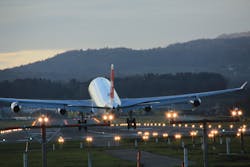Make Durable and Affordable Halogen and Xenon Lamps Part of Your Economic Transition Plan
For every airport, large or small, safety always comes first, which means finding the right products for runway, taxiway and approach lighting is paramount. Airfield lighting must perform well in both day and night, and through poor weather conditions, such as in fog, rain, snow and high winds. While many large, international airports driven by mandates to reduce energy usage and lower their environmental footprint have already transitioned to LED lighting, many smaller municipal and regional airfields still rely on the affordability and durability that halogen and xenon lighting can provide.
It is true that LEDs have a long life and use less energy. However, there are no LED drop in replacements for existing fixtures that use halogen lamps. LED lights may save money in the long run but transitioning to this lighting solution can be an expensive proposition. For many airports, grant money, like those awarded by the FAA or state transportation boards, is the only practical means of adopting LED lighting. The good news is that airports that don’t have access to grant money to have options for safe airfield lighting.
The first option is to stick with existing lighting that utilizes halogen and xenon. These solutions continue to offer safe, reliable lighting, but it doesn’t have to be a permanent solution if your airport ever chooses to begin the transition to LED, which could take many months or years depending on the size of the airfield. The second option offers a happy medium between installing a new LED lighting system and sticking with an existing solution. Under this scenario, airports install LED lights incrementally as their budget permits, replacing existing lighting section by section. For this to work, each section must be changed at a time.
The Detroit Metropolitan Wayne County airport tried this hybrid option with great success. The airport has moved incrementally from incandescent to LED lighting since 2006, replacing taxiway lights in 2008, followed by 245 centerline lights in 2013, and 180 touchdown zone lights on Runway 4L-22R in 2016. Following completion of the project, the airport received a silver award from the Institute for Sustainable Infrastructure.
Of course, airports that want to transition to LED lights incrementally will need a convenient, affordable product with high availability for the sections that are not yet being replaced. With incandescent bulbs being phased out of production, the remaining choices in today’s market are halogen and xenon solutions.
Hence, the enduring popularity of halogen and xenon. Halogen lamps can be used for almost all of an airfield’s needed lighting, including runways, taxiways, airfield guidance signs and approach systems such as VASI, PAPI and MALSR. Xenon lamps also remain a reliable choice for approach lighting systems, especially when a strobe is used such as on MALSR systems and for airfield obstructions like towers and other structures around the airfield.
If there is grant money or other funding for LED lighting, mixing LED with halogen and xenon, section by section, offers a great alternative. Lasting up to 1,500 hours, halogen lighting offers longevity as well as the durability to withstand the strong vibrations from airplanes landing and taking off throughout the day. Even with the long life of LEDs, there are some noteworthy drawbacks to consider. Halogen generates heat to prevent ice build-up when temperatures dip below freezing giving them an advantage over LED lights, which require an external heating source. In addition to the lack of a heating source, LED lights may decline in brightness over time and may require repairs due to breakage or other factors. Beyond that, LEDs are still a new technology on airfield grounds while halogen and xenon have proved their worth as a reliable source of lighting in all types of conditions. They have been tested, tried and proven reliable for more than 30 years.
The adage “time is money” certainly also applies to maintaining airfield lighting. As mentioned earlier, halogen lamps can deliver up to, if not more than, 1,500 hours of lamp life, which reduces operating costs overall as well as the need to send maintenance crews to change out bulbs helping to keep runways and taxiways open.
After cost, every decision must also consider function. Halogen lamps are a durable lighting option that can outperform LED lights on a variety of measures, including the ability to withstand the harsh vibrations of aircraft landings and takeoffs and poor weather conditions such as variations in temperatures, ice buildup, snow, high winds and more. Halogen lamps can withstand these conditions thanks to advancements in the design of filaments. Additionally, a well-made halogen lamp will maintain candela output — the measurement of illumination produced by an output beam — that exceed industry standards.
Choosing the appropriate type of lamp for airfields not only contributes to reducing airfield maintenance costs and ensuring the maximum return on investment for airfield authorities, and possibly taxpayers, more importantly, it can ensure the safety of pilots, crews, passengers and those working on the airfield such as fuelers and other driving on and around taxiways.
In the selection of lamps for airfields, it is important to purchase lamps from reputable manufacturers. All products in use should meet or exceed the standards set by ANSI (American National Standards Institute), the FAA and be approved for use by those organizations. Qualified manufacturers carefully test their products in a range of environments in labs to ensure their performance, durability and longevity.
The economic challenges being experienced in the travel industry today will continue to make finding affordable options for all the new challenges more imperative than ever. Keeping a close watch on expenses is key to maximizing operating efficiencies and continues to be an important driver for the industry. Airports that lack funding for a wholesale LED replacement may want to consider halogen solutions that offer a host of benefits for meeting the lighting requirements of today, as well as a cost-effective incremental transition to LED lighting in the future.
John Fogel, Halogen Product Manager at Amglo, has worked with the company for more than 10 years in product development, qualifying products with the FAA, and building partnerships. For more information, visit www.amglo.com
About the Author

John Fogel
Halogen Product Manager
John Fogel, Product Manager at Amglo, has worked with the company for more than 15 years in product development, qualifying products with the FAA and building partnerships. For more information, visit www.amglo.com.
